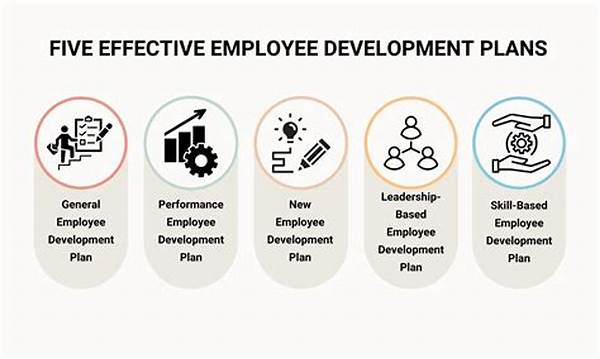In today’s rapidly evolving business landscape, organizations are increasingly recognizing the importance of strategic employee development plans. Such plans are pivotal in fostering a workforce that is not only skilled but also adaptable to the ever-changing demands of the industry. Strategic employee development plans ensure that employees are equipped with the necessary skills and knowledge to perform their roles effectively while also preparing them for future challenges and opportunities.
Read Now : Expressive Arts Training For Kids
Importance of Strategic Employee Development Plans
The implementation of strategic employee development plans is essential for maximizing an organization’s potential. By aligning development goals with strategic business objectives, companies can enhance employee capabilities, streamline operations, and drive growth. This approach not only improves individual performance but also fosters a culture of continuous learning and development. Employees who feel supported in their professional growth are more likely to engage positively with their work and exhibit greater commitment to organizational goals. Moreover, strategic employee development plans help in identifying and nurturing high-potential employees, ensuring a strong leadership pipeline. By investing in employee development, businesses can reduce turnover rates and attract top talent, thereby securing a competitive advantage in the marketplace.
Additionally, strategic employee development plans require careful planning and execution. Organizations must conduct regular assessments of skills gaps and training needs to tailor development activities effectively. This involves setting clear objectives, selecting appropriate training methods, and evaluating the impact of development initiatives on both individual performance and organizational success. By taking a strategic approach to employee development, businesses can create a dynamic workforce capable of meeting current and future challenges.
Components of Strategic Employee Development Plans
1. Assessment of Current Skills: Strategic employee development plans begin with a comprehensive assessment of the current skills and competencies of the workforce. This ensures that development initiatives are targeted and effective.
2. Setting Development Goals: Clearly defined and aligned with organizational objectives, these goals serve as guiding principles for employee development activities.
3. Customized Training Programs: Tailoring training programs to meet individual and team needs ensures that strategic employee development plans are relevant and impactful.
4. Mentorship and Coaching: Providing mentorship and coaching opportunities strengthens employee capabilities and encourages a culture of learning and growth.
5. Regular Progress Evaluation: Routine evaluation of employee development progress is crucial to ensure alignment with strategic goals and make necessary adjustments.
Benefits of Strategic Employee Development Plans
Strategic employee development plans provide a myriad of benefits, both for employees and the organization as a whole. These plans help in building a skilled workforce that is adaptable, motivated, and aligned with the company’s strategic goals. They enable organizations to close skill gaps, prepare employees for future roles, and enhance job satisfaction through continuous learning opportunities. Moreover, strategic employee development plans foster employee engagement and retention, reducing the costs associated with high turnover rates. By investing in their development, companies demonstrate a commitment to their employees’ professional growth, which in turn results in increased loyalty and productivity. Furthermore, such plans help in creating a leadership pipeline, ensuring that the organization is well-prepared for succession planning and future challenges.
Read Now : Affiliate Marketing Guide For Beginners
Key Factors in Designing Strategic Employee Development Plans
When designing strategic employee development plans, several key factors must be taken into account. Firstly, it is crucial to conduct a thorough analysis of the current skills and competencies within the organization to identify gaps and areas for improvement. Secondly, setting specific, measurable, achievable, relevant, and time-bound (SMART) development goals is essential to ensure the effectiveness of the development plans. Thirdly, providing access to diverse learning opportunities, such as online courses, workshops, and on-the-job training, helps in catering to the varied learning preferences of employees.
Moreover, organizations must foster a culture that promotes continuous learning and encourages employees to take ownership of their development journey. A successful strategic employee development plan also includes regular feedback mechanisms, allowing employees to track their progress and make adjustments as needed. Finally, the involvement of leadership in endorsing and participating in development initiatives is vital in reinforcing their importance and ensuring organizational alignment.
Challenges in Implementing Strategic Employee Development Plans
Implementing strategic employee development plans is not devoid of challenges. One of the primary obstacles is aligning development initiatives with the organization’s strategic goals while also catering to the individual learning needs of employees. Moreover, resistance to change from both employees and management can hinder the successful implementation of development plans. Additionally, the lack of adequate resources, such as time, budget, and training materials, can impede the development process. Organizations also face the challenge of keeping development plans relevant in the face of rapidly changing industry dynamics. To overcome these challenges, companies must prioritize open communication, provide adequate support, and regularly review and update development plans to ensure their continued effectiveness.
Summary of Strategic Employee Development Plans
In conclusion, strategic employee development plans are integral to the sustained success of modern organizations. By investing in employee growth, organizations not only enhance individual performance but also achieve broader business objectives. Strategic employee development plans provide a structured approach to developing skills and competencies, ensuring employees are equipped to meet current and future challenges. Organizations must overcome various challenges, such as resource constraints and resistance to change, to successfully implement these plans. By fostering a culture of continuous learning and aligning development initiatives with strategic objectives, companies can create a motivated and adaptable workforce.
Furthermore, strategic employee development plans play a crucial role in employee engagement and retention. Employees who see a clear path for their growth and development within the organization are more likely to remain committed and motivated. This not only results in higher productivity but also solidifies the organization’s reputation as an employer of choice. In an increasingly competitive business environment, the strategic development of employees is not merely an option but a critical necessity for organizations aiming to thrive and stay ahead of the curve. Through dedication to strategic employee development plans, companies can ensure long-term success and sustainability.
